

 The South African
The South African
Background
Essentially the British Sovereign's personal troops, the Household Division is a unique formation within the British Army. The Guards, as they are more commonly known, are seen as part of the traditional pageantry of Britain, impressive in their turnout and drill and associated with such ceremonial parades as Changing the Guard at Buckingham Palace, the Tower of London and Windsor Castle, and Trooping the Colour at the Sovereign's Annual Official Birthday Parade.
In South Africa, no provision was made within the Union Defence Force (UDF), forerunner of the present South African National Defence Force, for an elite unit with the specific task of providing a dignified ceremonial role forthe Head of State (originally the Governor-General, representing the British Sovereign) and for the country. Over the years, many Active Citizen Force (ACF) units were used in this role when required. On many occasions, for example, the Cape Town Highlanders provided a Guard of Honour at the State Opening of Parliament. However, this was only a secondary role. The ACF units themselves were not Permanent Force units with full-time professional soldiers as found in elite and ceremonial units in other countries around the world. The State President's Guard was formed later, in 1967, to fill this role until it was disbanded in 1989 (CassinScott & Fabb, 1973, plate 67; SANMMH File 355,31 (68) The State President's Guard). Today, the National Ceremonial Guard carries out ceremonial duties in South Africa.
Even so, it is difficult to identify the State President's Guard and the National Ceremonial Guard with the regiments of the British Household Division whose tradition of service and excellence goes back such a long way. This tradition, along with the Guards' discipline and precision, has never been compromised and will always be a matter of pride to the Guards and the British nation as a whole (Keene, pp 111-2). The Guards are also, first and foremost, operational troops, fully trained in every aspect of modern warfare and they may be deployed to all parts of the world where necessary. Thus, they are required to be equally efficient in both forms of service, ceremonial and operational, and to maintain the highest standards in both. The fact that this is achieved is testimony to their one basic principle, that nothing is acceptable which is in any way second rate (Paget, 1976, pp 1624).
This article looks at the association of the Household Division with South Africa over the past century. Before we begin, however, a brief discussion of the composition of the Household Division is provided.
Composition of the Household Division
The Household Division comprises two components, namely the Household Cavalry and the Foot Guards.
The Household Cavalry maintains squadrons of the Life Guards and the Blues and Royals (Royal Horse Guards and Royal Dragoons). The Life Guards, the senior regiment of the British Army, were originally divided into two regiments, the 1st and 2nd Life Guards, but were amalgamated in 1922. The Blues and Royals came into being in 1969 when the Royal Horse Guards (the Blues) were amalgamated with a separate cavalry regiment, the Royal Dragoons (1st Dragoons) to form a new regiment of Household Cavalry. In 1991, the Household Cavalry was divided into an armoured reconnaissance regiment for operational duties, and the Household Cavalry Mounted Regiment for the ceremonial role. Both the Life Guards and the Blues and Royals maintain their identities within this regiment (Paget, 1976, pp 21, 174, 270; Skilton, 1992, p 70).
The Foot Guards, formally referred to as the Brigade of Guards, consist of the following five regiments, in order of seniority: the Grenadier Guards, the Coldstream Guards, the Scots Guards, the Irish Guards, and the Welsh Guards. Since 1991, each regiment maintains only one battalion, which alternates between operational tours of duty and their ceremonial role in London (Paget, pp 21-2; Skilton, p 70).
All the Guards regiments, except for the Irish Guards and the Welsh Guards, can trace their existence back to the seventeenth century around the time of the English Civil War and the restoration of Charles II as King. The Life Guards and the Grenadier Guards were formed from bodies of men who accompanied Charles into exile as his personal guard. Both the Royal Horse Guards (the Blues) and the Coldstream Guards were part of Cromwell's Parliamentary Army, but placed themselves at the King's disposal upon his restoration in 1660. The Scots Guards were first raised in 1642, before any of the other regiments, but, owing to their disbandment in 1651 and incorporation into the English Army only in 1686, despite their re-establishment in 1660, they are today, according to the order of precedence, the third regiment of the Foot Guards (Simkin and Gibbs, 1982, pp 2-10).
The Irish Guards will be discussed in greater detail below. The Welsh Guards, however, were formed in 1915 during the First World War to help to achieve demographic representation of the British Isles amongst the Guards. Since 1968, the Household Cavalry and the Brigade of Guards have been designated the Household Division under the command of the General Officer Commanding, London District (Paget, 1976, pp161,270).
The Guards and the Anglo-Boer South African War, 1899-1902
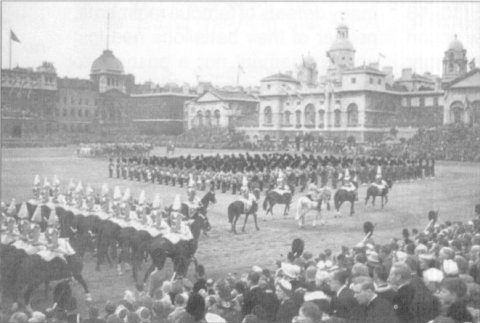
The Life Guards prepare to march past the Queen
during the Trooping of the Colour on the occasion of
Her Majesty's Official Birthday (Photo: By courtesy, SANMMH).
The association between the Household Division and South Africa begins with the outbreak of the AngloBoer War and the formation of an army force sent to fight the Boers. The Household Cavalry Composite Regiment was the first unit to be sent to South Africa and served with the 2nd Cavalry Division throughout the initial campaign. It remained in South Africa until November 1900, after which it returned home (Paget, 1976, p148).
The 1st Guards Brigade, which comprised 3 Bn Grenadier Guards, 1 Bn Coldstream Guards, 2 Bn Coldstream Guards, and 1 Bn Scots Guards, joined Lord Methuen's force sent to relieve the beleaguered British garrison at Kimberley. The Brigade took part in the battles in the Northern Cape leading up to Black Week (10-16 December), when they saw action . at Magersfontein on 11 December (Goodings, 1969, p 77).
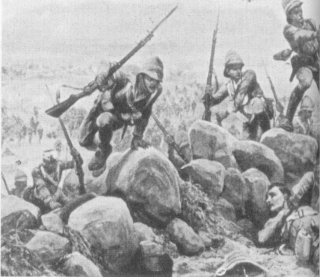
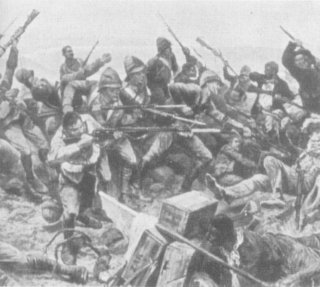
Irish infantrymen storm Pieter's Hill, Natal
February 1900. (Simkin & Gibbs, The Guards)
Following these disasters, more British and Imperial reinforcements were sent to South Africa and two additional Guards battalions, 2 Bn Grenadier Guards and 2 Bn Scots Guards, accompanied them, increasing the number of Guards units in the region to seven.
As the war progressed, the Boer republics were annexed by the British. The Boer commandos, however, remained elusive and turned to guerilla warfare, living off the land with no defensive positions, no camps and no lines of communication. To combat this, the British established a series of lines of fortified blockhouses across the country in an attempt to restrict the movement of the guerillas. New mobile units were created as well to protect the forts and to chase down the Boers. These included two Guards' mounted infantry companies comprising recruits from all four regiments of the Foot Guards at the time (Goodings, 1969, p 76; Paget, 1976, pp 150-1 ) .
Finally, after the capitulation of the Boers in May 1902, the Guards, both Cavalry and Foot, returned home. The Scots Guards, in particular, were proud and satisfied that, in a war which had witnessed many defeats of famous regiments, neither of their battalions had lost an engagement nor a prisoner to the Boers (Goodings, 1969, p 77).
Formatiom of the Irish Guards
It is accepted that the Sovereign's fourth regiment of Foot Guards, the Irish Guards, owes its establishment to the plight of the Irish regiments in South Africa during the Anglo-Boer War, 1899-1902. During Black Week, mentioned above, the British suffered a number of humiliating defeats at the hands of the Boers, including the battles of Magersfontein, Stormberg, Colenso and Spionkop. The only comfort the British people derived from these early disasters was that the soldiers themselves had served gallantly and none more so than the Irish regiments who suffered many casualties at the time. Following these failures, the relief of Ladysmith saw some of the most bitter fighting of the war and, here again, the Irish regiments distinguished themselves while suffering further terrible casualties. News of these events moved Queen Victoria herself to cable the following to Gen Sir Redvers Buller in February 1900 (Verney, 1970, p 2): '... I have heard with the deepest concern of the heavy losses sustained by my brave Irish soldiers. I desire to express my sympathy and my admiration of the splendid fighting qualities which they have exhibited throughout these trying operations.'
An even greater expression of appreciation for the bravery of the Irish soldiers in South Africa was pending as, on 1 March 1900, the following letter to the editor appeared in the Sunday Times (quoted by Verney, 1970, p 3):
Sir,
May I venture to suggest, through you, to the authorities within whose province it may come, that now is the most opportune time to recognize the distinguished valour of our Irish soldiers, who in the Inniskilling Fusiliers, the Dublin Fusiliers and the Connaught Rangers, have shown the world such conspicuous bravery in the many recent battles which they have fought with such brilliant dash and daring throughout our South Africa War. Is there not one mark of distinction and honour that can be conferred upon them and their country which belongs to Scotchmen [sic] and Englishmen, but is withheld from them? There are Scotch [sic] Guards and English Guards - why not add to the roll of glory a regiment of Irish Guards?
I am, Sir, your obedient servant, Summing Macdona, House of Commons, February 28th, 1900.'
This question was placed before Parliament and, from there, events moved rapidly. Queen Victoria approved of the idea entirely and on 1 April 1900, Army Order No 77 was issued: 'Her Majesty the Queen having deemed it desirable to commemorate the bravery shown by the Irish Regiments during the operations in South Africa in the years 1899-1900 has been graciously pleased that an Irish Regiment of Foot Guards be formed to be designated the Irish Guards.' And so, the Irish Guards, with Lord Roberts, Commander-in-Chief in South Africa at the time, as their first colonel, came into being (Verney, 1970, p 3).
Maj Gen W H E Poole and his association with the Guards
The conclusion of the Anglo-Boer War ended the Guards' involvement with South Africa for some time. Throughout the First World War (1914-1918), there was no direct association, other than that the 1st South African Brigade served on the Western Front in France alongside the Guards Division.
Several South Africans have served in, or been attached to, a Guards regiment from time to time. One of the more famous of these was an officer of the Union Defence Forces named William Henry Everard Poole. Poole eventually attained the rank of major general during the Second World War (1939-1945) and led the 6th South African Armoured Division, the largest South African formation ever to depart the shores of our country, throughout the campaign in Italy during the last two years of that war.
In 1935, as a temporary lieutenant-colonel and after a period of service as Officer Commanding the Special Service Battalion in South Africa, Poole was sent to the United Kingdom. There, he was attached to the Brigade of Guards at the. Guards Depot in Caterham and, during the following month, trained with the Brigade's Machine Gun Concentration at Warminster, Salisbury Plain. Over the next three months, he spent time with three Guards battalions: 2 Bn Grenadier Guards, 1 Bn Scots Guards and 1 Bn Welsh Guards. Whilst serving with the Grenadier Guards, he took part in the Royal Review of the British Army by King George V and was presented to the King that same day.
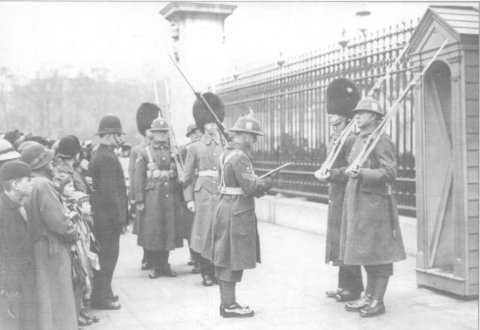
Members of the South African Coronation Contingent of 1937
take over guard duty at Buckingham Palace from 1 Bn Welsh Guards.
(Photo: SANMMH).
Poole's experience, gained over a period of four months with the Guards, paved the way for an important association to be formed later during the coming war (SANMMH, File 920 Poole).
The Second World War, 1939-1945
As in the First World War, there was no direct South African association with the Guards during the first years of the Second World War. It was only during the June 1942 crisis in North Africa that South Africans and the Guards were thrust together rather unexpectedly. After the withdrawal of the British Eighth Army from the Gazala line, only the hastily put together Tobruk garrison lay in the path of the advancing Axis forces.
This garrison consisted of the 2nd South African Division under the command of Maj Gen H B Klopper, who was also garrison commander, and a handful of British and Indian brigades, including the 201st Guards Brigade. This Brigade had originally comprised 3 Bn Coldstream Guards and 2 Bn Scots Guards, with 9 Bn The Rifle Brigade as its third battalion. However, prior to the siege of Tobruk, both the Scots Guards and the Riflemen had been detached, leaving only the Coldstream Guards to endure the fateful siege with the South Africans. Yet, even though the garrison and the 2nd Division were forced to surrender on 21 June, 200 Guardsmen and some 200 from other units under Major Tim Stainthill of the Coldstream Guards managed to make it back to Allied lines (Orpen, 1971, pp 311-14; Paget, 1976, p 196).
The 24th Guards Brigade and the 6th South African Armoured Division
On the conclusion of hostilities in North Africa in 1943, the Allied High Command took the decision to invade Italy, then ally of Germany in the Axis Pact. The 6th South Africa Armoured Division, raised that same year, was earmarked for service in that theatre. The Division comprised, as did all British armoured divisions, one armoured and one motorised infantry brigade. However, owing to the mountainous terrain in which the Division would have to operate, it was considered necessary to provide it with an additional infantry component. The 24th Guards Brigade, comprising 5 Bn Grenadier Guards, 3 Bn Coldstream Guards and 1 Bn Scots Guards was subsequently allocated to the Division (Keene, p 112).
One may have expected some dissatisfaction on the part of the Guards at this decision. It is generally accepted that formed bodies of Guards regiments and battalions are commanded by their own officers or by an officer who is qualified to become a 'Guards General'. This practice ensures that the character and historic tradition of the Guards are maintained. In light of this, it would have been unthinkable that a Guards brigade might be placed under the command of what would probably have been considered a foreign, Dominion army with standards that were incomparable to those of the Guards (Keene, p 112).
Nevertheless, on 20 May 1944, the Brigade officially came under the command of HQ 6th South African Armoured Division and for nine months an association existed between the Guards and the South Africans. This association was described by Capt the Hon D H Erskine, official historian of the Scots Guards, as ' ... the happiest of the campaign - if not the whole war' (Keene, p 114; Paget, 1976, p 214). The success of the association can be attributed to the stature of the General Officer Commanding the Division, Maj Gen W HE Poole. As previously mentioned, Poole had been attached to the Guards Brigade in 1935 and his experience with them is likely to have contributed to the high regard in which the Springboks were held. In all likelihood, it also 'qualified' him for command in the eyes of the Guardsmen, who maintain that, 'once a Guardsman, always a Guardsman' (SANMMH, File 920 Poole ).
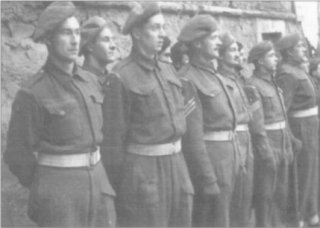
Men of 3 Bn Coldstream Guards wear the triangular yellow and green flash
of the 6th South African Armoured Division in Italy. (Photo: SANMMH).
The Brigade fought with the Division until 17 February 1945. During that time, the high regard in which the 6th SA Armoured Division was held was manifested by the Guards in different ways. The regimental history of the Coldstream Guards records that ' ... it was a marked breach of tradition for the men of the 3rd Battalion to wear a divisional sign, used as they were to sport only a Roman III on their sleeves; but even the most conservative was proud to wear on his battledress the green and yellow triangle of the 6th SA Armoured Division' (Keene, p 117). One Guardsman even felt it necessary to express his feelings for the Springboks in the following letter published in Division's magazine, The Sable (quoted by Keene, pp 117-8):
'Hello Springboks! Somebody ought to tell you about yourselves, so why not I? !t's a pleasure. I like you. Nobody with a red tab on his shoulders has told me yet how big the skyscrapers are in Cape Town and I haven't heard yet that you are winning the war for us. You grouse as much as I do, and about the same things, but it's always a private grouse and you keep it in the family. When we first got together, you knew us - mind you, we've been in British divisions who couldn't tell one guardsman from another. British troops generally are never unanimous in their opinions of anything or anybody - of course with the agreed exceptions but I've yet to hear any guardsman who doesn't want to stay in "Our Div". There's a general satisfaction with the news that the flash is now on our vehicles, and that's significant. Yes, we've never been out of sound of your tracks and wheels since we came among you. Where a Sherman has not got to go, has been due to mechanical impossibility and
you've proved it by trial. This may not be sound brasshat economics but it's very convincing to the footslogger. Even if it means a tank out of commission, he knows you had a damn good try, and although I wish every mother's son of you a speedy return to the kopjes and kloofs of sunny SA, I hope you'll see the Guards Bde through these deadly hills first! - I'll trek along with you.'
The end of the association was regretted on both sides and it was also recorded in the official history of the Cold stream Guards that ' ... it meant saying goodbye to the South Africans'. The Pretoria Regiment was perhaps most closely associated with the Guards as they had provided much of the armoured support for the Brigade. At the farewell parade held on 26 March 1945, the Regiment was permitted to wear the winged blue-red-blue flash of the Household Division, still worn today behind their headdress badge. The significance of the wings is that, on several occasions, the Regiment had managed to get their tanks supporting the Guardsmen into such inaccessible positions in the mountains that it was remarked that ' ... they must have flown there.' In appreciation, the Pretoria Regiment presented each of the Brigade's battalions with a mounted impala head, the emblem of the Regiment. At the same parade, the 24th Guards Brigade provided the 6th SA Armoured Division with 9 company colour of 5 Bn Grenadier Guards and the commanding officer's flags of 3 Bn Coldstream Guards and 1 Bn Scots Guards (Keene, p 121; Paget, p 216). These flags and colour can be seen in the display featuring the 6th South African Armoured Division at the South African National Museum of Military History in Johannesburg.
On 18 June 1944 the Guards Chapel, located in Wellington Barracks in London, was hit by a V1 flying bomb. The disaster occurred during the Sunday morning service and 121 people were killed. Much of the building was destroyed. As a token of their regard for the Guardsmen, the men of the 6th SA Armoured Division contributed £5 000 towards rebuilding the Chapel. This gesture ' ... aroused the deepest feelings of gratitude throughout the Brigade of Guards.' The gift was used to purchase new bronze doors for the main entrance of the Chapel and to renovate the mosaics in the apse. Today the bronze doors carry both the star of the Household Division and the green and gold flash of the 6th South African Armoured Division (Keene, p 122; Paget, 238).
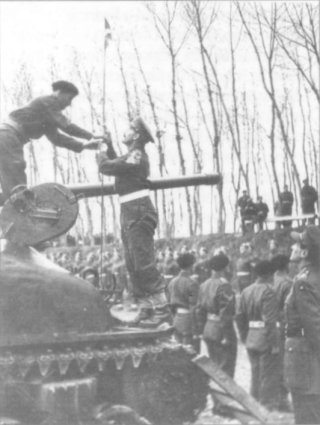
The Pretoria Regiment receives a pennant from
the 24th Guards Brigade. (Photo: SANMMH).
Conclusion
In the past, there was a strong association between South Africa and the Household Division. It is unfortunate that, in the years following the establishment of the Nationalist Party Government in 1948 and the withdrawal of South Africa from the Commonwealth in 1961, much of this association was lost as a result of the country's isolation in military affairs. It is also unfortunate that no South African regiment was able to establish an affiliation with one of the Guards regiments as was achieved by regiments from Commonwealth countries such as Canada and Australia.
Nevertheless, certain links were maintained through the formation of the Guards Association of Southern Africa. Membership of this association, officially constituted in 1984, is reserved for those who have either served with, or have been closely associated with one of the seven regiments of the Household Division. It is hoped that, with the political transformation which has occurred in our country over the last decade, a new association may be formed. South Africa is currently in the process of building a new national defence force and our servicemen would do well to emulate the traditions, standards and discipline of the Household Division.
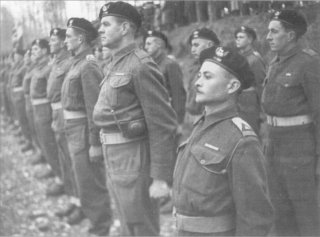
Members of the Pretoria Regiment proudly wear the winged flash
of the Household Division behind their headdress badge. (Photo: SANMMH).
REFERENCES
Cassin-Scott, J & Fabb, J, Ceremonial uniforms of the world (Stephen Hope, London, 1973).
Goodings, A. The Scots Guards (Leo Cooper, London, 1969).
Keene, J L, 'The 24th Guards Brigade and the 6th South African Armoured Division' in Museum Review, Vol 2 No 3.
Orpen, N, War in the Desert (Purnell, Cape Town, 1971).
Paget, J, The Story of the Guards (Osprey, London, 1976).
Skilton, W, British Military Band Uniforms: The Household Division (Midland Publishing, Leicester, 1992).
Simkin, P & Gibbs B, The Guards (London, Pitkin Pictorials Ltd, 1982).
Verney, P, The Micks: The Story of the Irish Guards (Peter Davies, London, 1970).
South African National Museum of Military History Archives, File 355.31 (68),
The State President's Guard; File 920, Poole Maj GenW H E.
Return to Journal Index OR Society's Home page
South African Military History Society / scribe@samilitaryhistory.org